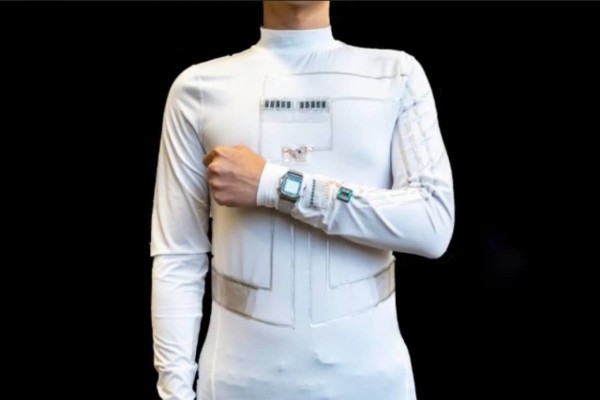先日、"あれっ????車のドアロックができなかった。"キーを近づけたらできたけど。一瞬焦ってしまいました。すぐに電池交換。バッテリー切れは困りますよね。
今回はマイクログリッド(小型電力供給源)がプリントされたスポーツシャツを着て、運動して、汗をかくと電気が充電され、その電気をディバイスに送ることができる便利なシャツが開発さてた記事です。
静電気と発熱シャツでさえ苦手な私はNothanksですが。
2022/2/5 level 8
Could Our Clothes Soon Power Electronic Devices?
衣服からディバイスに充電
Could our clothes soon be powering digital devices?It looks possible.
衣服からディバイスに充電する。これは可能かもしれない。
Researchers from the University of California San Diego have developed a "wearable microgrid" that collects and stores energy from movement and sweat.
カリフォルニア大学の研究員は”ウェアラブル・マイクログリッド”を開発した---それは動きや汗からエネルギーを集め、蓄える。
The microgrid can be printed onto clothing and produces enough energy to power small electronic devices.
マイクロリッジは衣服の上からプリントでき、小型の電子ディバイスに電力を供給することが可能。
画像:credit:University of California-San Diego
The microgrid connects three main parts: motion-powered generators, sweat-powered biofuel cells, and energy-storing supercapacitors — which are a bit like batteries.
マイクロリッジは3つのメインパートにつながっていて、動きからの発電機、汗で発電するバイオ燃料電池、スーパーキャパシター:バッテリーのようなもの。
The motion-powered generators are printed on the outside of a sports shirt, on its forearms and near the waist.
動きからの発電機は、スポーツシャツの外側にプリントされていて、下腕(肘から手首)とウエストあたりに付いている。
So, when a person wearing it swings their arms, the generators rub against each other to create high voltage electric pulses.
だから、それを着用して腕を振ると発電機とが摩擦され高い電圧の電子パルスが生じる。
When the wearer starts to sweat, the biofuel cells, which are on the inside of the shirt, start working to produce a low voltage.
着用者が、着用し汗をかいた時に、シャツの中側のバイオ燃料電池が働いて低い電圧を産みだす。
And they keep going even when the wearer has stopped moving.
着用者が動きを止めた時でも作動しつづける。
The electricity from the motion-powered generators and the sweat-powered biofuel cells is then stored by the supercapacitors, which are also printed on the shirt, and which then release the energy to power small devices.
動きからの発電機が作る電気と、汗からのバイオ燃料電池はスーパーキャパシターで蓄えられる---それらはプリントされているシャツから小型ディバイスに電気が送られる。
Lu Yin, co-first author of the study, said the advantage of using both biofuel cells and motion-powered generators is that they work together to create continuous energy.
バイオ燃料電池と動きからの発電機を一緒に使うことで、共に作動し電気を作り出し続けるのが強み。
For example, in a test, the microgrid was able to power a digital watch during a 30-minute session that included 10 minutes of exercise and 20 minutes of rest.
テストでは、マイクログリッドは30分間デジタルワッチを使う場合、10分動いた後20分の停止しても作動する。
Arm movement immediately caused the motion-powered generators to start working, charging the supercapacitor for as long as the exercise continued.
腕の動きはすぐに動きの発電機の作動が始まる---エキソサイズが長ければ長いだけスーパーキャパシターにチャージされる。
The sweat-powered biofuel cells started working after about five or six minutes of exercise, and continued to keep the supercapacitor topped up even after exercise ended.
汗のバイオ燃料電池はエキソサイズの数分あとに作動が始まる---そしてエキソサイズを終えたあとでも満たされたスーパーキャパシターをキープする。
The study also noted that the microgrid is flexible and was not affected by being folded 100 times — or even by a 20-minute wash.
マイクログリッドは耐久性があり、100回使用、20分洗濯に耐えられる。
The researchers are also working on other designs that could generate electricity with less vigorous movement — like working in an office
ほかの種類も設計している---それほど動かなくても発電するタイプを---オフィス用に。
記事引用:
